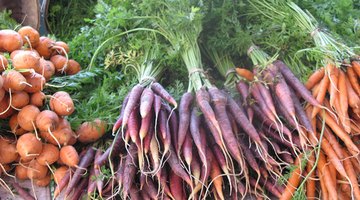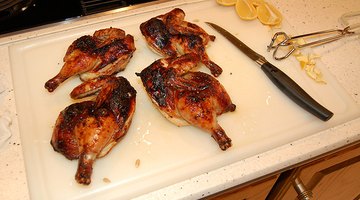Teaching your children or students about the Middle Ages can be an exciting part of their education, as well as their creativity. Outlining a lesson plan that includes the diets of the people during Medieval times is a valuable way to incorporate enrichment with education. Not only will the children learn recipes from historic times, they will learn about the different habits of the people that lived in the Middle Ages.
Popular Medieval Foods

Staples of the Medieval diet included breads, fish, meats and potatoes. Educate the students on how kingdoms and royalty relied heavily on foods that were obtained through fishing and hunting, as well as their own gardens. Gather some of the more common medieval foods for the recipes, such as heavy wheat rolls, Cornish game hens and large brown-skinned potatoes. Other vegetables like purple carrots and turnips were also widely eaten in the Middle Ages.
- Staples of the Medieval diet included breads, fish, meats and potatoes.
- Gather some of the more common medieval foods for the recipes, such as heavy wheat rolls, Cornish game hens and large brown-skinned potatoes.
Preparing Your Medieval Feast

Use a home-smoker oven and smoke a whole salmon, making sure it is properly cleaned beforehand. Put two or three Cornish game hens on a rotisserie, and only season the meats with herbs that were common to the Middle Ages, like rosemary, sage, thyme and mint. Salt can be sparingly used, as it was used to cure meats for royalty during Medieval times, although it was sparse. Boil the potatoes with the skin on, after thoroughly scrubbing them in warm water, until they are tender, and then slice each potato in half. Bake the soft potato halves and carrots in a rack underneath the roasting hens to create a traditional European roasted potato dish. Serve all of the foods in a platter in the centre of a dining table and place the table with pewter dishes and utensils, as was common practice during Medieval times. Children can easily use a home-smoker under an adult's supervision, as with a home rotisserie oven as well.
- Use a home-smoker oven and smoke a whole salmon, making sure it is properly cleaned beforehand.
- Serve all of the foods in a platter in the centre of a dining table and place the table with pewter dishes and utensils, as was common practice during Medieval times.
Easy Fruit Salad
Teach your students or children about the importance of fresh fruits in the diets of people during Medieval times. Have them prepare a traditional fruit salad comprising of fruits that were common to diets in that era. Grapes, oranges, figs and dates were common, as well as blueberries, blackberries, cherries and plums. Mix about two cups of thick and sweetened whipped cream to a pound of the fruit salad for an added treat.
- Teach your students or children about the importance of fresh fruits in the diets of people during Medieval times.
